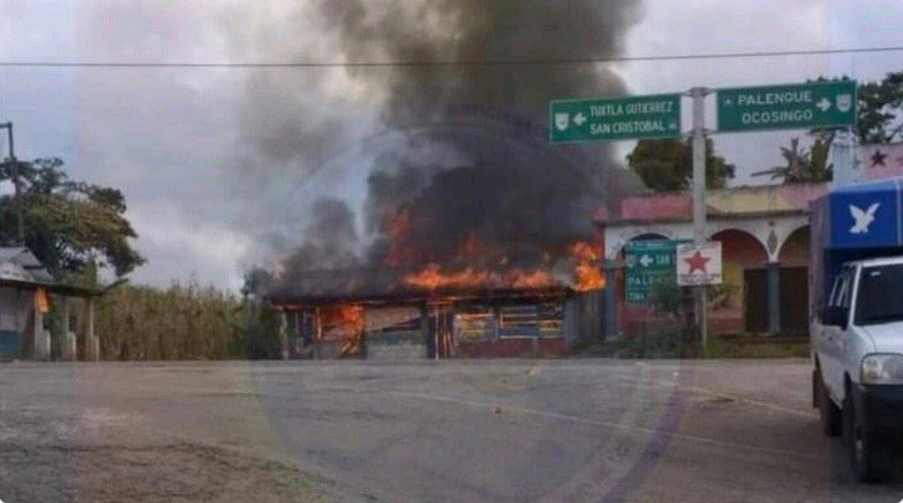
By Luis Hernández Navarro
Chiapas burns. The masters of the paramilitaries hand them the reins, and emboldened, they do what they will. They attack the rebel communities with firearms, they have the luxury like in Santa Martha of showing off with weapons and uniforms and disarming the state preventive police.
Just this 22nd of August, a group of truck drivers belonging to the Regional Organization of Coffee Growers of Ocosingo (Orcao) that live in the municipality of Oxchuc, led by Tomás Santiz Gómez, shot at, robbed and burned two coffee warehouses of support bases of the Zapatista Army of National Liberation (EZLN) in the community of Cuxuljá, rebel municipality of Moisés Gandhi (Ocosingo, in official nomenclature).
Cuxuljá is a little town on the road between San Cristóbal and Ocosingo. It is surrounded by eight Zapatista autonomous municipalities and is the crossroads of diverse communities. It was occupied by the [Federal] Army until 2001. The army withdrew its position in order to comply with the three signals that the EZLN demanded of the government of Vincente Fox to re-establish dialogue.
The withdrawal of the troops did not bring peace to the region. As soon as the dialogue failed, due to the approval of the constitutional reformst around indigenous rights and culture that failed to comply with the Accords of San Andrés, aggressions of the paramilitary group Orcao, against the rebel bases of the community began. Their objective was to occupy the territory left by the troops.
Orcao was not always like this. Over some years, it had a close relationship with zapatismo. However, this link broke between 1997 and 1999, and its leadership began to dispute the rebel social base, with economic support and government posts for its leaders. Witht the arrival of the state government of Pablo Salazar (2000-2006), the conflict escalated. In 2002, the attacks of the organization against the Zapatista bases intensified dramatically, to the point of destroying a rebel mural. It had become a paramilitary force.
Orcao was formed in 1988, with 12 communities of Sibacjá in the municipality of Ocosingo. Before long, other villages joined, almost making it 90. Their original demands consisted as much in the search for the best coffee prices (which plummeted drastically in 1989), as in the resolution to the agricultural backwardness. Influenced by the progressive pastoral work, in 1992, in the content of the commemoration of 500 years of indigenous, black and popular resistance, it reclaimed indigenous self-determination, opposed the reform of Article 27 of the Constitution and demanded liberty, justice and democracy. (https://bit.ly/3goUvWS)
However, it suffered an unstoppable decay. It was practically expelled from Unorca in 2015. Internally divided, two groups fight over its leadership, that of José Pérez, linked to Greens (Party) and the control of passenger transport, and that of Juan Vázquez, commissioner for the reconciliation in the government of Jan Sabines, more oriented toward production. Allied with the governments in power, its leaders have enjoyed, to their own personal benefit, positions in public administration. Many of them were part of the PRD, the PVEM, and now of Morena.
There is a long history Orcao’s aggression against Cuxuljá. As a result of the uprising, the EZLN bases of support (a collective of 539 campesinos) were beneficiaries of 1,433 hectares expropriated from plantation owners. They hold an act of delivery-reception from the Secretary of Agrarian Reform.
The Zapatista work the land in collective and refuse to parcel it out individually. They assert that doing so would be like returning to 1994. However, a small group from Orcao that abandoned the community and sold their homes, originally supported by the Army and the police, have been insisting for 19 years on dividing the land, getting certificates, and selling individually what is a product of a common struggle.
Attacks on EZLN support bases by the Orcao have been a constant. They are not limited to Cuxuljá, but cover several municipalities. The last one took place on February 23rd in Chilón, when Orcao itself,the Chinchulines and members of Morena violated and kidnapped community representatives in retaliation for participating in the Days in Defense of the Territory and Mother Earth Samir Somos Todas y Todos (https://bit.ly/3leg3cs).
These aggressions have been carried out regularly in the context of government offensives, in order to try to weaken zapatismo and restrict its advance. They are not a product of inter-community feuds, but the result of a strategy of fabrication of internal conflict on the part of the state. The governments in power (including the current one) support Orcao with economic resources, productive projects (many are cattlemen), political cover, and police impunity in order to erode and wear down the EZLN.
Just a year ago, the rebels announced the creation of 7 additional new caracoles to the 5 existing ones giving them a total of 43 instances of self-governance, unrelated to the official government bodies. Additionally, they have announced their rejection of the Mayan Train and the Interoceanic Corridor. The new battle of Cuxuljá and the unending war of the paramilitaries of Chenalhó are part of a strategy of containment against the advance of Zapatismo. A strategy that doesn’t seem to worry about the burning of the state.
This article was originally published in Spanish in La Jornada on August 25th, 2020. https://www.jornada.com.mx/2020/08/25/opinion/017a1pol This English interpretation has been re-published by Schools for Chiapas.
